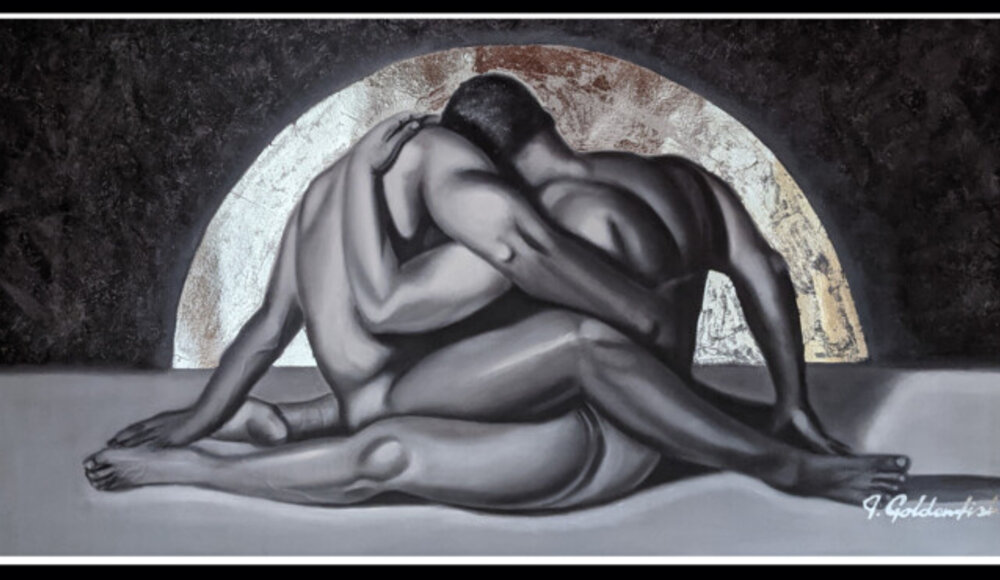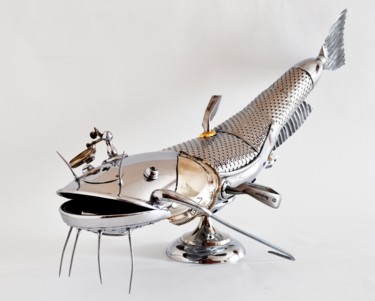 Irina Goldenfish, Silver moon, 2021. Oil on canvas, 60 x 118 cm.
Irina Goldenfish, Silver moon, 2021. Oil on canvas, 60 x 118 cm.
Silver: the color of the moon
Taking a purely chromatic point of view, silver represents a shiny gray-metallic color, found in nature through the observation of silver fish, silver birch trees and the metal from which it inherited its very name. Such a shade, which is extremely popular in interior design precisely because of its brightness, as well as its modern, elegant and refined appearance, is known to be the hue associated with the moon, that is, with that exclusively feminine energy, inextricably linked to emotions and drives, which move within us at the deepest level. In fact, the Earth's natural satellite, capable of attracting to itself the water of the Earth's surface closest to it, causing the tidal flow, seems to invoke, in quite a similar way, the emotions, creativity and sensuality in us most innermost. In fact, it is believed that precisely in water, ruled by the moon, is concentrated all the inner life of the human being, having its origin, together with unconscious forces, in the generating principle of the womb, a feminine place allusive to our most remote origins. In this sense, just such a hue symbolizes the awareness of our interiority, achieved through that path we must take to recognize ourselves, our inner world and our emotionality, in order to be able, at a later time to "identify" others as well.
 Isabelle Pelletane, Love Love 15, 2022. Acrylic / spray paint on paper, 70 x 50 cm.
Isabelle Pelletane, Love Love 15, 2022. Acrylic / spray paint on paper, 70 x 50 cm.
 Ilgvars Zalans, Silver and black nr.6, 2019. Acrylic on canvas, 90 x 60 cm.
Ilgvars Zalans, Silver and black nr.6, 2019. Acrylic on canvas, 90 x 60 cm.
Silver in art: from Verrocchio to Jeff Koons
From a purely art-historical point of view, the color silver, as anticipated, derives its name from the metal of the same name, which, extremely popular in the creative and goldsmithing world since the earliest centuries, has certainly contributed to the diffusion and ennobling of the aforementioned color. In fact, it is important to make it known that, since the time of the ancient Egyptians, the use of silver, a metal, which, at the time rarer than gold, was used to create precious religious artifacts and showy jewelry, can be found. Appreciated by the Greeks as well, silver enjoyed a fair amount of success in 15th-century Italy, when, thanks to the artistic investigation of great masters such as Lorenzo Ghiberti, Andrea del Verrocchio, Antonio del Pollaiolo and Domenico Ghirlandaio, the art of goldsmithing reached the pinnacle of perfection. In addition, in this same period, the Florentine engraver Maso Finiguerra, defined in Benvenuto Cellini's Trattato dell'Oreficeria as, "The man who is unrivaled in that profession", distinguished himself in the art of niello, a specific technique for decorating metal surfaces in silver. The Renaissance style, exclusively marked by classical models, can, however, be exhaustively narrated by the analysis of a masterpiece of the period, such as Andrea del Verrocchio's The Beheading of the Baptist, i.e., one of the twelve panels forming part of The Silver Altar of St. John the Baptist, a toreutic work made by various artists between 1367 and 1483 for the baptistery of San Giovanni (Florence), now preserved in the Museo dell'Opera del Duomo (Florence). The altar represents an extraordinary synthesis of the main trends in goldsmithing and sculptural art of the time, expressed through a structure in late Gothic matrix, having eight front panels and four side panels, arranged on two registers and divided by polygonal pillars enriched by the presence of small statues and niches. At the center of this articulated composition is the aedicule with the statue of the saint, which, along with the rest of the artifact records the presence of silver, enamel, gilding and wood components. Speaking of the twelve panels, the last is the one in which the aforementioned Beheading of the Baptist is depicted, which, despite being universally recognized as the work of Verrocchio, could also be attributable to the work of Leonardo da Vinci. In fact, the latter was a pupil of Verrocchio during this same period, in which his stylistic features were marked by a particular perspective construction, Classical architecture, and dramatic emotional reactions, which can be seen in the very last panel of the altar. Taking a temporal leap of about seven centuries, it is possible to point out how the recurrence of silver in contemporary art turns out to be somewhat "unchanged," although predominantly related to the popularity of the shimmering color, rather than to the use of the metal itself, which is often "simulated" through the use of related, but less expensive and more readily available materials, such as, for example, stainless steel and aluminum. Demonstration of what has just been stated is Jeff Koons' famous Louis XIV, a glittering sculpture, which, made in 1986 from stainless steel, depicts the American master in the shoes of the former ruler of France, pursuing the purpose of celebrating, both the extreme sensuality of the Baroque-style forms and the cult of the artist's own personality. It is precisely the aforementioned metal that has been employed in the creation of the sculpture series of which Louis XIV is a part, which, titled Statuary, is aimed at celebrating the peculiarities of the color silver in Baroque, nostalgic and contemporary kitsch creations, designed with the intention of extending from eternal themes to decidedly more ephemeral subjects. After Jeff Koons' point of view, it is important to highlight how the narrative of silver color can be enriched by unprecedented points of view, expressed by the original work of Artmajeur artists such as Ricky Reese, Richard Orlinski and Alan Lawrence.
 Laurent Fauchoix, Dolphin tail, 2018. Metal, 37 x 12 / 2.00 kg.
Laurent Fauchoix, Dolphin tail, 2018. Metal, 37 x 12 / 2.00 kg.
 Pablo Alfredo De La Peña, Commencing countdown, 2022. Wood on wood, 38.1 x 40.6 x 45.7 / 4.00 kg.
Pablo Alfredo De La Peña, Commencing countdown, 2022. Wood on wood, 38.1 x 40.6 x 45.7 / 4.00 kg.
 Ricky Reese, Silver flower, 2022. Stainless steel sculpture, 65 x 44 x 30 cm / 23.00 kg.
Ricky Reese, Silver flower, 2022. Stainless steel sculpture, 65 x 44 x 30 cm / 23.00 kg.
Ricky Reese: Silver flower
The artistic investigation of Ricky Reese, a Spanish sculptor born in 1956, often experiments with the use of silver-plated metals, which are engaged in order to create minimalist narratives, aimed at describing synthetically and, in part even geometrically, the features of reality. Exemplifying what has just been stated is the case of Silver flower, a stainless steel sculpture whose elegance, sobriety and idea of movement, tends to recall the work of Rosette Bir, a French artist known for her abstract works in polished stainless steel. Speaking of the metal that united the "material" choices of the two sculptors, stainless steel turns out to be extremely popular in contemporary art, especially with regard to that artistic production used for outdoor public uses, where such ferrous alloy tends to be perfect, as it does not rust and resists the attacks of liquids, of gases and chemicals. The above appears with evidence in the work of one of the best known contemporary artists, such as sculptor Anish Kapoor, who in 2006 created, in reflective stainless steel, one of the most popular monumental attractions in Chicago (USA), namely the Cloud Gate, a sculpture whose "physiognomy" was inspired by the peculiarities of liquid mercury.
 Richard Orlinski, Silver bull, 2015. Aluminum, 69 x 122 x 43 cm.
Richard Orlinski, Silver bull, 2015. Aluminum, 69 x 122 x 43 cm.
Richard Orlinsk: Silver bull
Silver bull is a shimmering sculpture made of aluminum by popular French artist Richard Orlinski, whose work has been largely influenced by Pop art stylings as well as the features of popular everyday objects. Despite this apparent "superficiality" and "lightness," the Artmajeur artist's works conceal, behind a purely consumerist veneer, deep content, alluding to important values, such as, for example, freedom, power and passion. These ideals are predominantly expressed through the use of reflective and "dazzling" materials, probably intended to symbolize a pseudo "cry," which allows concepts of such depth to be more easily disseminated. Consequently, Silver bull could allude to the aforementioned concepts, but also to others, found in well-known masterpieces of art history having the same subject, such as, for example, the famous Bull of Wall Street, a monument, which, created by Arturo Di Modica in 1987 and placed in the Financial District of Manhattan (New York), stands to celebrate the virile courage of those who are able to fight against any adverse situation.
 Alan Lawrence, Weightless, 2021. Resin, glass and metal sculpture, 33 x 15.2 x 6.4 cm / 2.00 Ib.
Alan Lawrence, Weightless, 2021. Resin, glass and metal sculpture, 33 x 15.2 x 6.4 cm / 2.00 Ib.
Alan Lawrence: Weightless
The surrealism with which in Alan Lawrence's work a simple "hanging" spoon has arguably been transformed into an elegant symbol of balance, reminds me of a bygone era when precious and stately silver cutlery was used during meals. In fact, the latter metal was used to produce objects intended for table service, at least since the time of the ancient Phoenicians, enduring into the Roman, as well as later, periods. After the Medieval "pause," silver cutlery returned with vigor during the Renaissance, although a peak in its use was recorded beginning with the discovery of America, that is, when, thanks to the spread of metals from the New World, silver became accessible even to the bourgeoisie. Such "passion" for the aforementioned silverware, in addition to representing a kind of status symbol, is also due to actual practical advantages inherent in silver, as it turns out to be extremely hygienic, antibacterial and disinfectant. Returning to Artmajeur's artist, the American sculptor born in 1965 argues, that the boundary between a work of art and its audience should be as short as possible. Consequently, the use of cutlery within his artistic investigation, could pursue the purpose of accompanying the viewer within a reality already very familiar to him, where it is possible to recognize the simplicity of everyday gestures.


 Olimpia Gaia Martinelli
Olimpia Gaia Martinelli























